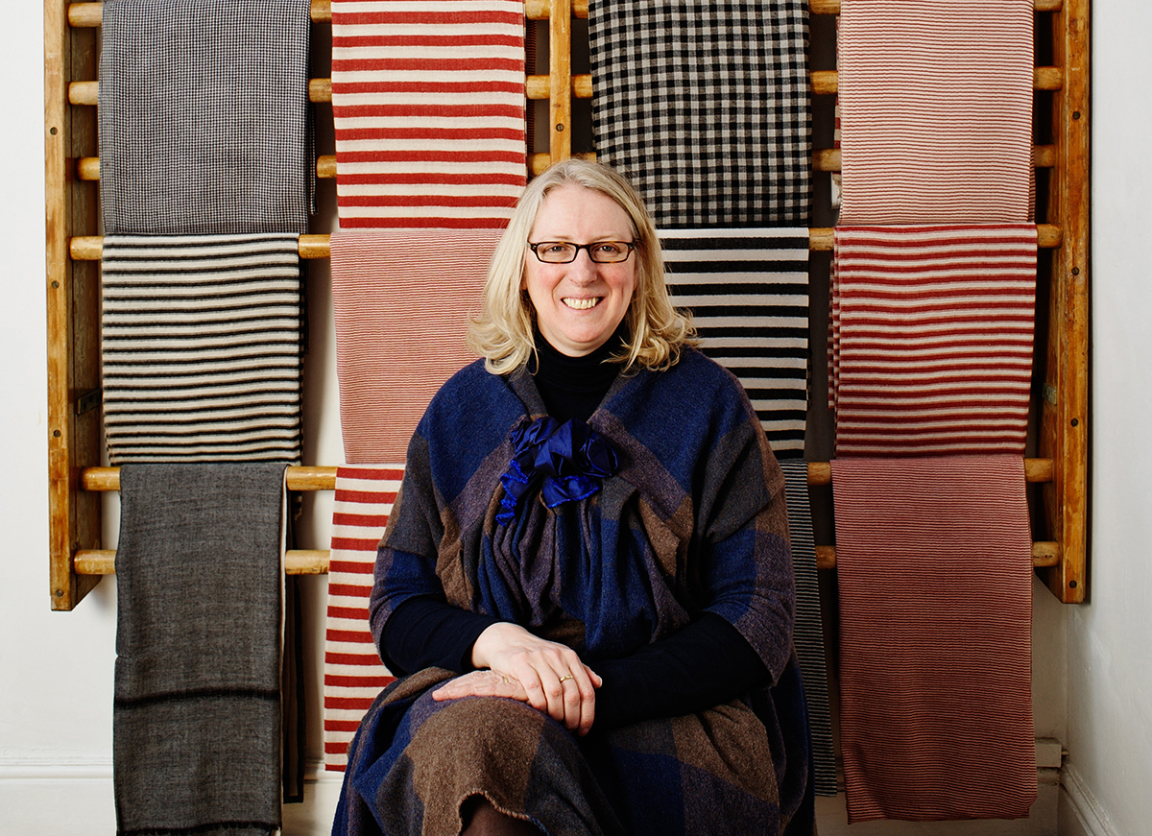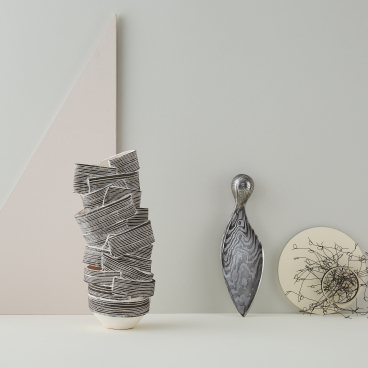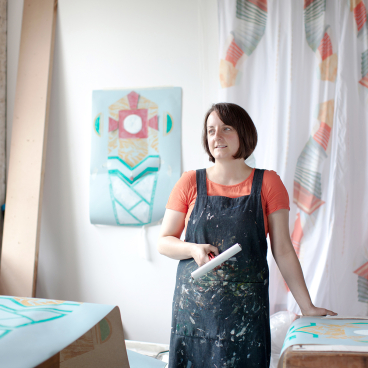Polly Leonard on dominating the textiles industry through championing raw design talent

Polly Leonard is Founder of Selvedge magazine, which was launched 12 years ago following a successful crowdfunding campaign. What originally started as a one-off publication created in Polly’s front room has since become the world’s leading textile magazine with over 45,000 readers.
Selvedge has expanded into an entire textile community with a shop, seasonal fairs, workshops and creative collaborations with the likes of the National Trust and Anthropologie.
With a plethora of experience in the textiles industry, and being a true champion of raw creative talent, we were keen to chat to Polly about what inspires her, and how she managed to put textiles back on the fashion agenda.
Tell us how you got here – how did you get started and what's happened along the way?
I started out making things; I have a degree in embroidery and weaving and a Masters in fibre art. I then taught textiles in schools for ten years and wrote articles for textile magazines on the side. I was offered a job editing one of the magazines I wrote for and I found I really enjoyed putting a magazine together.
While I was working on this magazine, I could see from the inside that there were too many amateur magazines out there that weren’t giving textiles its professional face. I had a different vision for the future of the magazine I was editing than the publisher, so we parted company and I decided to launch Selvedge.
The first thing I did was to make an A4 hand-out with details about me, my vision for Selvedge and the offer of a free copy of the first issue. I gave it out at a textile trade fair and managed to build up a database of 5,000 people to whom I sent the first issue.
From this, I got enough subscribers for me to make the next issue, and things have grown from there – I guess you could call it early crowdfunding. I now have over 45,000 readers based all over the world and the Selvedge brand has grown to include an online and bricks and mortar shop, seasonal artisan fairs, summer schools, creative collaborations and an international community of textile lovers.
I think the success of the magazine comes from the fact that I don’t really know anything about publishing, so it communicates a passion for textiles rather than what does or doesn’t work in terms of making a magazine. I think that’s what people love about it.
You've successfully merged printed magazine with an online shop to champion and support designers and producers… Tell us more.
I launched the shop partly to make the magazine financially viable – the magazine wouldn’t be feasible on its own. I also launched the shop as another way of supporting makers. The reason for the magazine’s existence is to promote textiles and another way of doing this is with the shop, fairs and the other things that we do. All of these things achieve the same goal.
Does the magazine fuel inspiration for the shop? Or is it the other way around?
The magazine comes first in most cases. So if I discover a nice product, I will feature it in the magazine before stocking it in the shop. The shop is really the magazine coming to life.
The Selvedge office is in the back of the shop. It's really important for me and my team to have physical things around us and the shop satisfies our need to have fabric close by while we work. It feels more ‘Selvedge’.
You've revolutionised the way materials are presented – how? What was the thought process behind how the magazine would feature materials?
The thought process was to put textiles centre-stage and not to hide them behind a fancy magazine design. I simply want to present beautiful things in the simplest way possible so that they can speak for themselves. The magazine isn’t really consciously designed, but it showcases textiles in a way that says ‘here they are, aren’t they gorgeous?’
What do you look for when choosing someone to shout about?
A high standard of craftsmanship. If something is not well made, I’m not interested.
I like interesting, unusual, quirky stories. I want something with integrity, I’m not interested in stories about designers working with artisans in the third world to preserve traditions, for example – I’ve heard it all before!
Next to food, textiles are the most important material in the history of humanity. You can live without most things, but you can’t live without textiles.
Tell us more about one or two recent designers and producers that have caught your eye...
Amy Revier – look out for her in the September issue. Her work epitomises a new movement to return to textiles that have a real physicality and obvious texture. Her work is a rejection of anything digital and high tech.
David Chalmers Alesworth, who has recently been shortlisted for the V&A’s Jameel Prize for Islamic Art, and Christina Kim, the designer behind the clothing, accessories and homeware line, Dosa. Both designers are in the current issue of the magazine.
It's been said that you've helped to put textiles back on the fashion agenda... Why do you think it went away?
I don’t think it went away; it’s just something that changes a lot. A few years ago there was a big pattern explosion, now this has died down and we’re looking at the texture. In the autumn it will be all about huge knits, big crochets and the structure of textiles, and then it will be something else.
Selvedge talks about cloth in a way that hasn’t been talked about before. Previously it was only cut that was talked about, but we talk about the fabric.
People are into 'making' again. Why do you think that's the case?
I think it’s all about instinct. People have an innate need to make things – and to make things as well as possible. A lot of energy is invested in making things and I think it’s all about survival. Back in the day if you made a better basket, you would be able to carry your vegetables better.
There’s also a real satisfaction around making something. You can spend four hours surfing the Internet or playing with a computer game and at the end of it, you won’t have achieved anything. If you spend four hours making something, you will feel amazing.
Making also connects people with each other and there’s a different set of values around something you have made rather than bought.
What's changed during your own career? Have you seen things come back in fashion? If so, what?
Art made from textiles is taken much more seriously. Also, everything is much more global now and it’s possible to find artists more easily. Thanks to the launch of Etsy anyone can be an artist and sell their work to an international audience.
The '70s are definitely back – they were a crafty time. At the moment, it’s all about pot plants, crochet, macramé, the colour brown. There’s a '70s style craft revival.
Anything you're glad to see the back of?
The 1950s were the high point in pattern design and the 1980s were a low point.
Do you have a favourite textile?
I like textiles that connect to humanity: Dutch Wax prints, American feed sacks (which we’ll talk about in our next issue), Khadi from India and Harris Tweed.
Next to food, textiles are the most important material in the history of humanity. You can live without most things, but you can’t live without textiles. Textiles can be used to make drinking vessels, shelter, clothing, nets for catching food. Textiles are vital for survival.
Describe a typical working day
There isn’t one, each day is different. I might be at a photo shoot, visiting an artist in their studio, giving a talk about textiles at a museum, overseeing a workshop in the South of France, welcoming exhibitors to one of our fairs, travelling to Sweden to judge an award. Or I might be in the office designing and editing the magazine and coming up with creative ideas with my team.
What do you always have on your desk? What's your work setup like?
I always have something to do with textiles on my desk – a ball of wool or a bit of shibori…Today I have a stack of beautiful books ready for review, a Japanese Hasami porcelain mug filled with fruit tea, a bottle of perfume I made myself, a supply of granola. The office is at the back of our shop in Highgate, north London. It’s a quirky space and we love it.
Finally, who has profoundly inspired you – and why?
Li Edelkoort – she’s a trend forecaster who used to make magazines called ‘Bloom’ and ‘View on Colour’. Also the stylist Nelson Sepulveda, the designer Bess Nielson from Khadi and Co, and Christina Kim from Dosa.
To find out more about Polly and Selvedge, visit the website www.selvedge.org.




